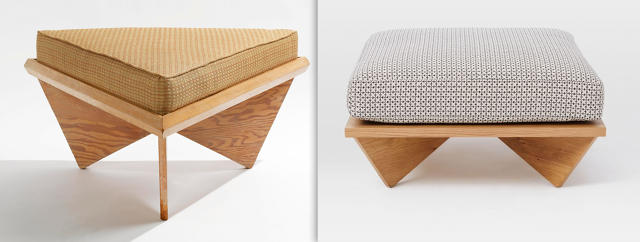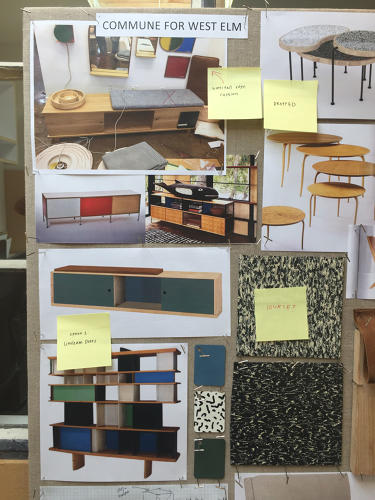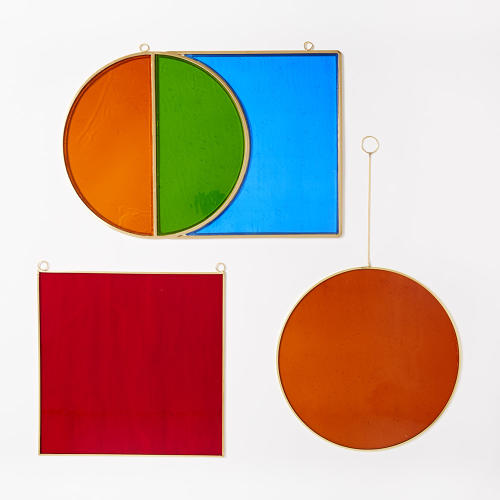Did West Elm Rip Off These Midcentury Masters?
Recently, the furniture giant West Elm and the L.A.–based design studio Commune released a collection of furniture and accessories with a midcentury-inspired sensibility. But as some bloggers were quick to point out, the “midcentury-inspired” looked more like a midcentury rip-off. The ensuing debate has raised pertinent questions about design plagiarism: Where do you draw the line between paying homage to a design classic and copying it? How close is too close?
On August 6, the design gallerist Patrick Parrish published comparisons between the new items from West Elm alongside furniture classics by icons like George Nelson, Hans Wegner, and Charlotte Perriand on his blog; many of the new pieces are dead ringers for the older works. As Parrish—who is a design expert and possesses more knowledge about furniture than the average consumer—pointed out, the Commune Low Cushion Ottoman shares the same inverted pyramid legs as a Bruce Goff c. 1957 ottoman. The Commune Tufted Ottoman looks eerily like Danish designer Kaare Klint’s c. 1933 ottoman. Parrish then made six more comparisons—and the likeness is uncanny in all of ’em. Mere coincidence?

“Some people felt that [our designs] were too close to the real thing to the original,” says Roman Alonso, one of Commune’s cofounders. “I think that’s something people need to be careful with [saying] because [the furniture pieces referenced] are part of design history. We all look at the past and we look at our heroes and whatever we love. Hopefully we’re bringing newness through that knowledge and experience.”
Alonso acknowledges that the collection treads into derivative territory, though he believes that Commune was acting more from a point of honoring the innovations that historic designers contributed to the canon. “Maybe we did get a little too close to those people, and now I look back and I’m a little uncomfortable by it,” he says. “I really don’t feel like there was anything done with any other intention than to bring really great things and design at a more accessible price to bring into their homes.”
Tracing their design process, and how ideas are molded into finished consumer products, offers some insight into how the project veered into questionable territory.

Alonso explains that when West Elm invited Commune to design a collection, the only directive was for the team to create pieces that the studio’s designers would like to have in their own homes. It was an opportunity to create affordable items that have the same eclectic, California-modern aesthetic Commune instills in its residential interiors—typically commissioned by wealthy clients. “We’ve never been snobs about design and recognize that good design comes at all price points and sometimes from the most unexpected sources,” Alonso says.
The 1.5-year-long design process began with inspiration boards that featured pinups of their favorite things; works from the Eameses, Perriand, Jean Prouve, Richard Neutra, Rudolph Schindler, and Frank Lloyd Wright made cameos. “There might be between 5 and 20 references to create one piece of furniture,” Alonso says. “But the first thing is always function—how it’s used and how it may fit into an environment. Then we look at the design, how it’s put together, and how it’s built.”

For the Commune Leather Sling chair, Alonso says he and his team mined a number of influences. The overall idea originated in the classic Mexican Butaque chair—a form that Alonso recalled from his childhood growing up in Latin America. He also admired the work of Clara Porset—a Cuban-born designer who worked with Luis Barragan but is little known. That reference, and particularly the stitching she used, made it into the final piece.
The inspiration board also included images of the Kangaroo chair Pierre Jeanneret designed for Chandigarh. Meanwhile, to inform the Commune Storage Bench, the designers looked at the Eames Storage Unit, and Perriand’s modular Nuage shelving for Cassina.

The iterating that occurs when the realities of mass production come into play also influenced the final pieces. After Commune made its preliminary sketches, the fabricators weighed in on whether or not they were structurally sound and mass producible at the price point West Elm wanted. Materials changed, silhouettes were simplified, and entire products got nixed. Eventually, the 100 or so designs that Commune sent to West Elm were whittled down to the 30 or so objects that are on sale.
The conversations between Commune and the fabricators, West Elm and the fabricators, and West Elm and Commune made it difficult to keep track of the distance between inspiration and finished pieces. “In the effort of making [the design] better, it becomes close to where you started, and you don’t remember how you got there . . . [The design] becomes yours during the process, but you’ve had the heroes in mind, so the inspiration goes through so many filters that then it becomes yours by process but is shared with them through history,” Alonso says. “And we’ve been up front about that. We credit these people.”

It’s true that Commune lists a few of the design heroes that influenced the collection on its Tumblr, but none of these references and credits made it into the final West Elm materials. Alonso says he provided a “narrative” of each piece to West Elm. “Unfortunately control over their marketing material is not in our hands,” he says. “They choose the message for their channels.”
We asked West Elm about its policy of reviewing designs for potential copycats. A company representative issued the following written statement: “We believe in the value and impact of design collaborations. We chose to work with Commune based on their signature Southern California expression and casual living style. We also believe in design integrity in everything we do, whether we design the product, as is the case with nearly 90% of our assortment, or in collaborations like we did with Commune where they led the design process.”

Plagiarism is reprehensible, but the market supports it, unfortunately. Corporations have copied artists for a long time. Yet this year, design theft by large corporations has become a major issue, and rightly so.
For example, a group of independent artist have mobilized against Zara, which is accused of stealing designs from over 20 artists; in response, one illustrator even launched a website where people can buy the originals. Last fall, Ikea famously lifted from midcentury designers, too, in the name of low-cost furniture. Meanwhile, earlier this month over 100 designers issued a statement in support of Apple in its suit against Samsung for the Korean company’s use of its patented design features. Their argument? Design is directly linked to a product’s success—and it needs to be protected.
Another challenge with protecting the intellectual property of older pieces is that design patents expire after 14 years and utility patents after 20, so it’s open season on borrowing some details. Some countries, like the United Kingdom, are taking steps to ban replicas of design classics. With Commune and West Elm, the differences are enough that nothing could be considered a replica.
It’s one thing for a small-scale designer to make a couple of custom pieces that reference classics, but when a multimillion-dollar business gets involved, the motivation seems less about paying tribute to an icon than pure profiteering, regardless of the original intent. The contradiction here is that West Elm prides itself as a champion of original, independent design.
We’ll probably never know who’s to blame in this debacle, but it raises many questions about the state of design and authorship today. Is borrowing from the masters a way to raise awareness of their enduring genius—an “imitation is the sincerest form of flattery” move? Or is it a savvy business strategy? Are the fans who call out these similarities simply being overzealous? Intellectual property as it relates to design is becoming more nuanced, and the debates more sophisticated. I suspect that there are many precedent-setting cases to come in the near future.
In the end, while Commune says it wasn’t trying to outright replicate the work of famous midcentury designers, the references are close enough to cry copycat. For customers looking for easy-to-find, relatively affordable furniture that nods to their favorite classics, the price cut comes at the expense of ethics.
[All Photos (unless otherwise noted): via Commune]
West Elm and L.A.-based design studio Commune recently launched a furniture collaboration. The similarities between the new designs and a handful of midcentury classics bring up the debate between inspiration and plagiarism.

Here’s an early sketch of a concept for a leather accent chair with canvas lacing.

The finished design represents a back and forth between Commune, West Elm, and fabricators.

The Commune and West Elm Low-Cushion Ottoman


The Commune and West Elm Low Leather Stool

The designers looked to some of their favorite midcentury pieces to inform the collection.

The Commune and West Elm Storage Bench

The Commune and West Elm Tripod Floor Lamp

The Commune and West Elm Marble-Topped Coffee Table

The Commune and West Elm Low Wooden Side Table (small)

The Commune and West Elm Low Wooden Side Table (large)

The Commune and West Elm Armless Sofa

The Commune and West Elm Shearling Chair

The Commune and West Elm Tufted Ottoman

Metal Wall Art by Commune and West Elm

Colored Glass Wall Art by Commune and West Elm

Planters by Commune and West Elm

Fast Company , Read Full Story
(146)







